Ingersoll-Rand 100-200 HP-75-160 KW, 125-200 HP-90-160 KW User Manual
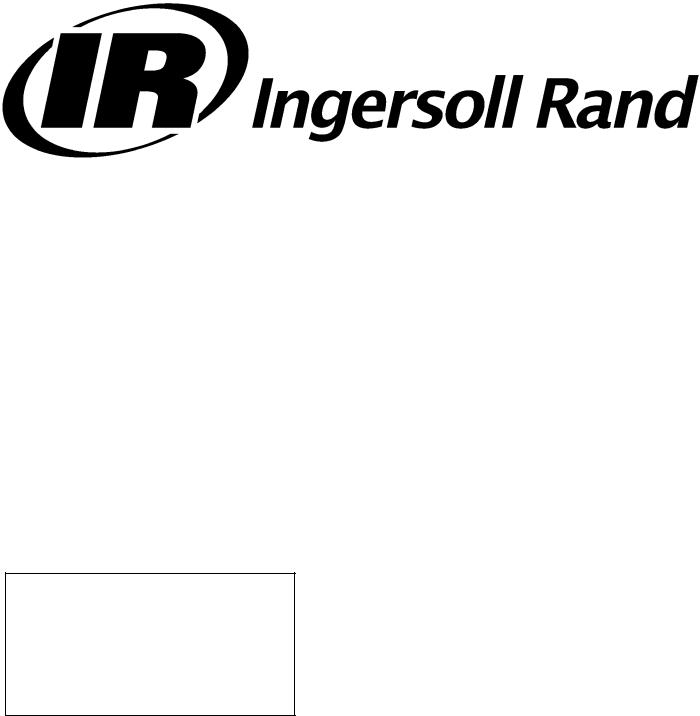
Before installation or starting the compressor for the first time, this manual should be studied carefully to obtain a clear knowledge of the unit and of the duties to be performed while operating and maintaining the unit.
RETAIN THIS MANUAL WITH UNIT.
This Technical manual contains IMPORTANT SAFETY DATA and should be kept with the air compressor at all times.
More Than Air. Answers.
Online answers: http://www.air.irco.com Phone: 1-800-526-3615
CCN: 80440415 REV: B
125-200 HP/90-160 KW SINGLE STAGE
AND
100-200 HP/75-160 KW TWO STAGE UNITS
OPERATORS/ INSTRUCTION MANUAL OPTIONS
FORM: APDD 738B
November 2002
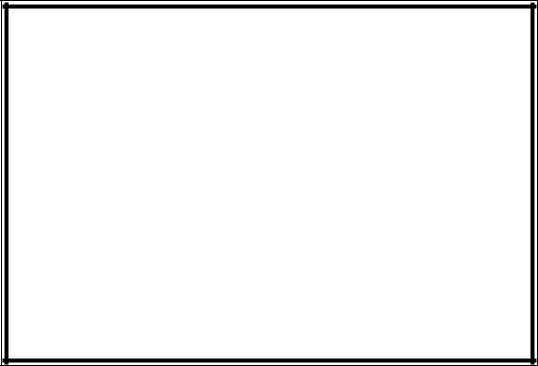
AIR COMPRESSOR GROUP
BONDED WARRANTY & REGISTERED START UP
Warranty
The Company warrants that the equipment manufactured by it and delivered hereunder will be free of defects in material and workmanship for a period of twelve months (see extended airend warranty) from the date of placing the Equipment in operation or eighteen months (see extended airend warranty) from the date of shipment from Davidson, NC, whichever shall first occur. The Purchaser shall be obligated to promptly report any failure to conform to this warranty, in writing to the Company in said period, whereupon the Company shall, at its option, correct such nonconformity, by suitable repair to such equipment or, furnish a replacement part F.O.B. point of shipment, provided the Purchaser has stored, installed maintained and operated such Equipment in accordance with good industry practices and has complied with specific recommendations of the Company. Accessories or equipment furnished by the Company, but manufactured by others, shall carry whatever warranty the manufacturers have conveyed to the Company and which can be passed on to the Purchaser. The Company shall not be liable for any repairs, replacements, or adjustments to the Equipment or any costs of labor performed by the Purchaser or others without Company’s prior written approval.
The effects of corrosion, erosion and normal wear and tear are specifically excluded. Performance warranties are limited to those specifically stated within the Company’s proposal. Unless responsibility for meeting such performance warranties are limited to specified tests, the Company’s obligation shall be to correct in the manner and for the period of time provided above.
THE COMPANY MAKES NO OTHER WARRANTY OR REPRESENTATION OF ANY KIND WHATSOEVER, EXPRESSED OR IMPLIED, EXCEPT THAT OF TITLE, AND ALL IMPLIED WARRANTIES OF MERCHANTABILITY AND FITNESS FOR A PARTICULAR PURPOSE, ARE HEREBY DISCLAIMED.
Correction by the Company of nonconformities whether patent or latent, in the manner and for the period of time provided above, shall constitute fulfillment of all liabilities of the Company for such nonconformities whether based on contract, warranty negligence, indemnity, strict liability or otherwise with respect to or arising out of such Equipment.
The purchaser shall not operate Equipment which is considered to be defective, without first notifying the Company in writing of its intention to do so. Any such Equipment will be at Purchaser’s sole risk and liability.
Note that this is Ingersoll-Rand’s standard warranty. Any warranty in force at the time of purchase of the compressor or negotiated as part of the purchase order may take precendence over this warranty.
©INGERSOLL-RAND COMPANY
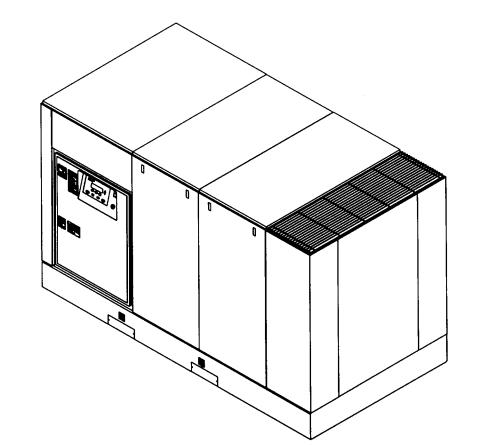
ROTARY SCREW AIR COMPRESSOR
This unit was purchased from:
_______________________________________________
_______________________________________________
_______________________________________________
Ingersoll-Rand Company reserves the right to make changes or add improvements without notice and without incurring any obligation to make such changes or add such improvements to products sold previously.
Number of units on order: __________________________
Customer Order Number: __________________________
Ingersoll-Rand Company Order Number: ______________
For ready reference, record the serial number and model number of your unit here:
Serial Number: ___________________________________
Model Number:___________________________________
1
TABLE OF CONTENTS
0.0SAFETY AND WARNINGS
0.1safety instructions
0.2safety precautions
0.3decals
1.0RECEIPT OF EQUIPMENT
1.1inspection
1.2unpacking and handling
1.3tools
2.0INSTALLATION
2.1ventilation
2.2foundation requirements
2.3piping
2.4electrical installation
2.5outdoor sheltered
3.0INTELLISYS®
3.1intellisys controls
3.2display screen
3.3current status
3.4main menu
3.5operator setpoints
3.6options
3.7sensor calibration
3.8alarm history
3.9warnings
3.10alarms
4.0SCHEDULED PREVENTATIVE MAINTENANCE
4.1maintenance schedule
4.2maintenance records
4.3maintenance procedures
4.4inlet air filter
4.5coolant filter
4.6coolant
4.7separator tank scavenge screen/orifice
4.8coolant separator element
4.9cooler cores (cleaning)
4.10motor lubrication
4.11long term storage
4.12coolant/lubricant changeout
4.13intellisys removal
4.14coolant hoses
4.15fluid and vibration monitoring
4.16coolant sampling procedure
5.0SYSTEMS
5.1general system information
5.2air cooled compressors
5.3coolant system
5.4compressed air system
5.5coolant/air separation system
5.6electrical system
5.7stepper motor inlet control
5.8capacity control system
5.9automatic start/stop control
5.10remote start/sto
6.0TROUBLESHOOTING
2
7.0OPTIONS
7.1power outage restart option
7.2sequencer
7.3low ambient
7.4separator delta-p solenoid
7.5separator delta-p sensor
7.6high dust filter
7.7lead/lag cycle length
7.8schedule start/stop
7.9remote load/unload
7.10modbus
7.11integral sequencing
8.0REFERENCE DRAWINGS
8.1electrical schematic, star delta
8.2foundation plan, 125/150 HP, A/C - Single Stage
8.3foundation plan, 200 HP, A/C - Single Stage
8.4foundation plan, 125/150 HP, W/C - Single Stage
8.5foundation plan, 200 HP, W/C - Single Stage
8.6foundation plan, 125/150 HP, A/C - Two Stage
8.7foundation plan, 200 HP, A/C - Two Stage
8.8foundation plan, 125/150 HP, W/C - Two Stage
8.9foundation plan, 200 HP, W/C - Two Stage
8.10flow schematic, A/C - Single Stage
8.11flow schematic, W/C-90°F (32°C) - Single Stage
8.12flow schematic, W/C-115°F (46°C) - Single Stage
8.13flow schematic, A/C - Two Stage
8.14flow schematic, W/C-90°F (32°C) - Two Stage
8.15flow schematic, W/C-115°F (46°C) - Two Stage
8.16typical system flow diagrams
9.0WATER QUALITY RECOMMENDATIONS
10.0MAINTENANCE RECORD
Weight .............................. |
See foundation plan, Section 8.0 |
|
Cooling Air Flow ............. |
See foundation plan, Section 8.0 |
|
Ambient Temperature Limits .......................... |
35°F to 115°F |
|
........................................................................... |
|
((2°C to 46°C) |
Coolant............................. |
Factory Filled SSR Ultra Coolant |
|
Coolant Change ............................ |
|
8000 hours or two years |
............................................................ |
|
whichever comes first |
Coolant Capacity |
|
|
125/200 HP (90-160 KW) - |
|
|
Single Stage ................................... |
|
23.0 gallons (87.4 liters) |
100 HP (75 KW) - |
|
|
Two Stage ....................................... |
|
22.0 gallons (83.3 liters) |
125-200 HP (90-160 KW) - |
|
|
Two Stage ..................................... |
|
30.0 gallons (113.6 liters) |
Discharge Temperature Limit ......................... |
228°F (109°C) |
|
Power Inlet Wiring ......................... |
|
Recommended conduit: |
............................metallic flexible Greenfield, or equivalent |
||
Tools .............................................. |
|
U.S. standard and metric |
................................... |
are required to perform maintenance |
|
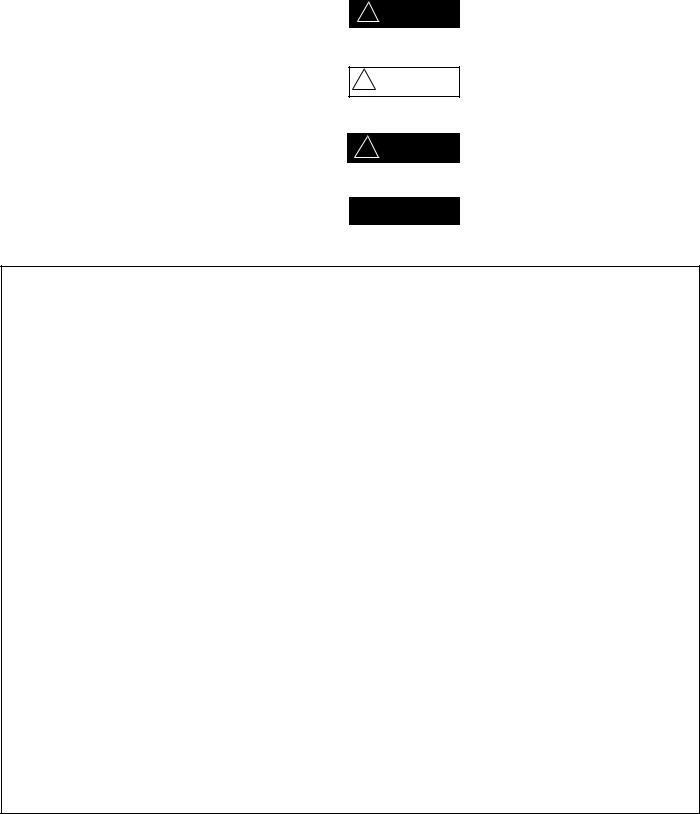
0.0SAFETY AND WARNINGS
0.1SAFETY INSTRUCTIONS
Before you install this air compressor you should take the time to carefully read all the instructions contained in this manual.
Electricity and compressed air have the potential to cause severe personal injury or property damage.
Before installing, wiring, starting, operating or making any adjustments, identify the components of the air compressor using this manual as a guide.
The operator should use common sense and good working practices while operating and maintaining this unit. Follow all codes, pipe adequately, understand the starting and stopping sequence. Check the safety devices by following the procedure contained in this manual.
Maintenance should be done by qualified personnel, adequately equipped with proper tools. Follow the maintenance schedules as outlined in the operators manual to ensure problem free operation after start up.
0.2 SAFETY PRECAUTIONS
Safety instructions in the operators manual are bold-faced for emphasis. The signal words DANGER, WARNING and CAUTION are used to indicate hazard seriousness levels as follows:
Danger is used to indicate the presence of
D! DANGER a hazard which will cause severe personal injury, death, or substantial property
damage if the warning is ignored.
Warning is used to indicate the presence of
! WARNING a hazard which can cause severe personal injury, death, or substantial property
damage if the warning is ignored.
Caution is used to indicate the presence of
! CAUTION a hazard which will or can cause minor personal injury or property damage if the
warning is ignored.
Notice is used to notify people of NOTICE installation, operation, or maintenance information which is important but not
hazard-related.
SAFETY PRECAUTIONS
BEFORE PROCEEDING, READ CAREFULLY BEFORE INSTALLING THE COMPRESSOR OR PERFORMING ANY MAINTENANCE
WARNING
COMPRESSED AIR AND ELECTRICITY ARE DANGEROUS.
BEFORE DOING ANY WORK ON THIS UNIT, BE SURE THE ELECTRICAL SUPPLY HAS BEEN CUT OFF–LOCKED & TAGGED AND THE ENTIRE COMPRESSOR SYSTEM HAS BEEN VENTED OF ALL PRESSURE.
1. Do not remove the covers, loosen or remove any fittings, connections or devices when this unit is in operation. Hot liquid and air under pressure that are contained within this unit can cause severe injury or death.
2. The compressor has high and dangerous voltage in the motor starter and control box. All installations must be in accordance with recognized electrical codes. Before working on the electrical system, be sure to remove voltage from the system by use of a manual- disconnect-switch. A circuit breaker or fuse safety switch must be provided in the electrical supply line leading to the compressor.
Those responsible for installation of this equipment must provide suitable grounds, maintenance clearance and lightning arrestors for all electrical components as stipulated in O.S.H.A. 1910.308 through 1910.329.
3.Do not operate the compressor at higher discharge pressure than those specified on the Compressor Nameplate or motor overload will occur. This condition will result in compressor motor shutdown.
4.Use only safety solvent for cleaning the compressor and auxiliary equipment.
5.Install a manual shut off valve (isolation type) in the discharge line. When a safety valve is installed between the isolation valve and the compressor, it must have sufficient capacity to relieve the full capacity of the compressor(s).
6.Whenever pressure is released through the pressure relief valve, it is due to excessive pressure in the system. The cause for the excessive pressure should be investigated immediately.
7.Before doing any mechanical work on the compressor:
a.) Shut the unit down.
b.) Electrically isolate the compressor by use of the manual disconnect switch in the power line to the unit. Lock and tag the switch so that it cannot be operated.
c.) Vent pressure from the compressor and isolate the unit from any other source of air.
8. There can be adverse effects if compressor lubricants are allowed to enter plant air systems.
Air line separators, properly selected and installed, will minimize any liquid carryover.
The use of plastic bowls on line filters without metal guards can be hazardous. From a safety standpoint, metal bowls should be used on any pressurized system. Review of your plant air line system is recommended.
9.When a receiver is installed, it is recommended that occupational safety and health standards as covered in the Federal Register, Volume 36, number 105, part 11, paragraph 1910.169 be adhered to in the installation and maintenance of this receiver.
10.Before starting the compressor, its maintenance instructions should be thoroughly read and understood.
11.After maintenance functions are completed, covers and guards must be replaced.
3
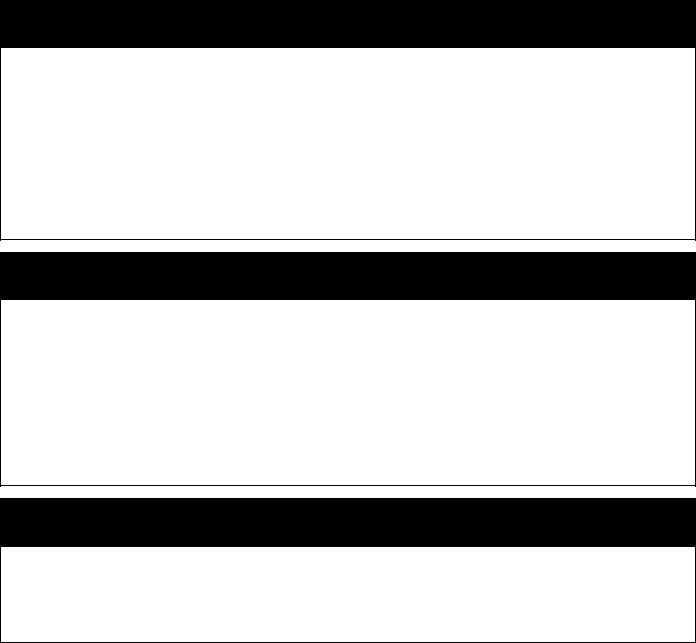
 SAFETY SHUTDOWN
SAFETY SHUTDOWN
CHECK HIGH AIR TEMPERATURE
There is a high discharge air temperature shutdown function built into the Intellisys on each compressor. It is factory pre-set at 228°F (109°C). This function should be checked at regular intervals for proper operation, once a month is recommended. The procedure is:
1.Block off the cooling air discharge.
2.The compressor discharge temperature will rise at a rapid rate. Shutdown should occur when the discharge temperature reaches the pre-set maximum discharge air temperature setting of the Intellisys. The display should indicate “HIGH AIREND DISCH TEMP” and flash “ALARM”.
The actual temperature at which shutdown occurs should be recorded for comparison to the Intellisys set point and with similar future test results.
 WARNING
WARNING
Failure to adhere to these recommendations can result in mechanical failure, property damage and serious injury or death.
All air and water inlet, and air and water discharge pipework to and from the inlet and discharge port connections must take into account vibration, pulsations, temperature, maximum pressure applied, corrosion and chemical resistance. In addition, it should be noted that lubricated compressors will discharge some oil into the air stream; therefore, compatibility between discharge piping, system accessories and software must be assured.
For the foregoing reasons, the use of plastic piping, soldered copper fittings and rubber hose as discharge piping is not recommended. In addition, flexible joints and/or flex lines can only be considered for such purposes if their specifications fit the operating parameters of the system.
It is the responsibility of the installer and owner to provide the appropriate service pipework to and from the machine.
 WARNING
WARNING
“Ingersoll-Rand air compressors are not designed, intended, or approved for breathing air. Ingersoll-Rand does not approve specialized equipment for breathing air application and assumes no responsibility or liability for compressors used for breathing air services.”
4
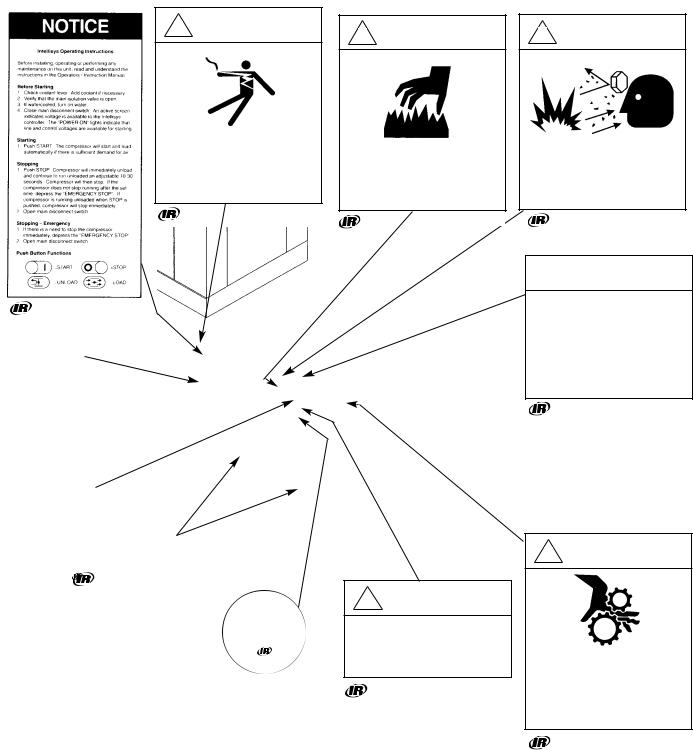
0.3 DECALS
This section contains representative examples of decals which will be appearing throughout this manual and are applied to the compressor unit. If for some reason a decal is defaced, painted over, or parts are replaced, we
recommend that you obtain a replacement kit as listed in the spare parts section of the Parts List Manual Form APDD 735 for single stage and Form APDD 736 for two stage units.
! WARNING
Hazardous voltage. Can cause severe injury or death.
Disconnect power before servicing.
Lockout/Tagout machine.
39540174 Rev. 05
39878657 Rev. 03
*PORO OPTION
39584529
*REMOTE START-
STOP OPTION 
39547708
*FOOD GRADE
COOLANT OPTION
39568803
|
|
|
|
|
|
|
VIEWED |
|
|
|
|
|
|
|
|
FROM |
|
|
|
Lift Here |
|
|
|
|||
|
|
|
|
|
FRONT |
|||
|
|
|
|
|
|
|
|
|
|
|
|
39540273 Rev. 04 |
|
|
|
|
|
|
|
|
|
|
|
|
|
|
|
|
|
|
|
||||
2 REQUIRED - BASE |
|
|
||||||
Filler Cap. |
||||||||
|
|
|
|
|
|
|
Use only |
|
|
|
|
|
|
|
|
|
|
recommended coolant.
Read instruction book before servicing.
39543921
39543921 Rev. 03
* FOOD GRADE COOLANT
OPTION ONLY
*ITEMS MARKED WITH * ARE OPTIONS THAT
ARE AVAILABLE
! WARNING
Hot surface.
Can cause severe injury.
Do not touch. Allow to cool before servicing.
39541362 Rev. 04
! CAUTION
Use of incorrect coolant can cause system contamination.
Use only SSR ULTRA COOLANT.
39540265 Rev. 05
* FOOD GRADE COOLANT
OPTION 39568464
! WARNING
High pressure air.
Can cause severe injury or death.
Relieve pressure before removing filter plugs / caps, fittings or covers.
39540240 Rev. 04
CAUTION
Improper maintenance of coolant filter can cause compressor damage.
Change coolant filter after first 150 hours of operation and every 2000 hours thereafter or when coolant is changed.
39544143 Rev. 03
! WARNING
Moving parts.
Can cause severe injury.
Do not operate with covers removed. Service only with machine blocked to prevent turn over.
39540224 Rev. 04
5
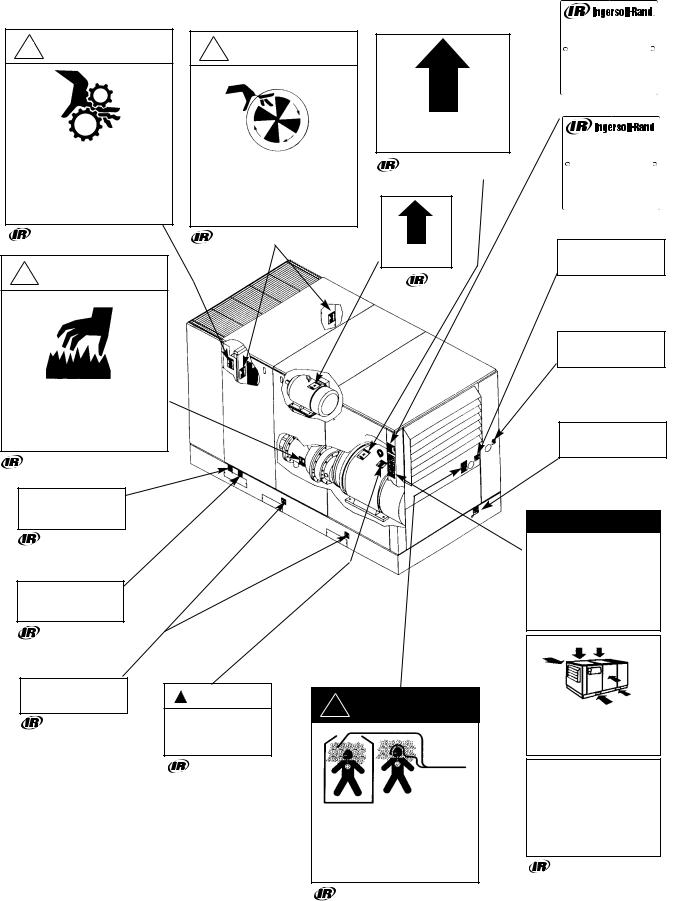
0.3 DECALS (continued)
! WARNING
Moving parts.
Can cause severe injury.
Do not operate with covers removed. Service only with machine blocked to prevent turn over.
39540224 Rev. 04
! WARNING
Hot surface.
Can cause severe injury.
Do not touch. Allow to cool before servicing.
39541362 Rev. 04
! WARNING
Rotation.
39540182 Rev. 04
Exposed fan blade. Can cause severe injury.
Do not operate with covers removed.
Disconnect power. Lock and tag.
39540190 Rev. 04
Rotation.
39544150 Rev. 03
*
Water out.
39541321 Rev. 04
*
Water in.
39541339 Rev. 03
Lift Here
39540273 Rev. 04
! CAUTION
Incorrect lifting of machine can cause injury or property damage.
Lift only from base channels.
39540232 Rev.03
* WATERCOOLED UNITS ONLY
VIEWED
FROM
REAR
! DANGER
Discharge air.
Can contain carbon monoxide or other contaminants. Will cause severe injury or death.
Do not breathe this air.
39540166 Rev. 06
Compressor Package Data
COMPRESSOR MODEL............................... |
m3/MIN |
CAPACITY...................................................... |
|
RATED OPERATING PRESSURE................. |
BARG |
MAX. DISCHARGE PRESSURE................... |
BARG |
MAX. MODULATE PRESSURE..................... |
BARG |
NOMINAL DRIVE MOTOR............................ |
KW |
NOMINAL FAN MOTOR................................ |
KW |
TOTAL PACKAGE AMPS...............................
VOLTS............................................................
PHASE / HERTZ............................................
CONTROL VOLTAGE.....................................
SERIAL NUMBER..........................................
CONTACTOR AMP. RATING.....................................
ASSEMBLY AMP. RATING........................................
LOCKED ROTOR AMP. RATING OF ASSY. ............
AIR SOLUTIONS GROUP
DAVIDSON, NORTH CAROLINA 28036 54425996 Rev.C
WWW.AIR.INGERSOLL-RAND.COM
54425996 Rev.C (75-160KW)
Compressor Package Data
COMPRESSOR MODEL............................... |
CFM |
CAPACITY...................................................... |
|
RATED OPERATING PRESSURE................. |
PSIG |
MAX. DISCHARGE PRESSURE................... |
PSIG |
MAX. MODULATE PRESSURE..................... |
PSIG |
NOMINAL DRIVE MOTOR............................ |
H.P. |
NOMINAL FAN MOTOR................................ |
H.P. |
TOTAL PACKAGE AMPS...............................
VOLTS............................................................
PHASE / HERTZ............................................
CONTROL VOLTAGE.....................................
SERIAL NUMBER..........................................
CONTACTOR AMP. RATING.....................................
ASSEMBLY AMP. RATING........................................
LOCKED ROTOR AMP. RATING OF ASSY. ............
AIR SOLUTIONS GROUP
DAVIDSON, NORTH CAROLINA 28036 39557095 Rev.05
WWW.AIR.INGERSOLL-RAND.COM
39557095 Rev.05 (100-200 HP)
Air
Discharge
 39540257 Rev. 04
39540257 Rev. 04
Electrical power inlet.
 39541354 Rev. 03
39541354 Rev. 03
Condensate
drain.
 39541081 Rev. 04
39541081 Rev. 04
NOTICE
To obtain satisfactory compressor operation and maintenance a minimum of 3 feet clearance on 3 sides is required 3-1/2 feet is required in front of
the control panel (or minimum required by latest National Electrical code or applicable local codes).
Refer to the Instruction / Operators
Manual before any maintenance.
Do not operate without enclosure panels and forklift covers in place.
Enclosure panels will affect performance.
Motors must be greased periodically.
See Operators Manual for procedure.
39857552 Rev. 04
6

0.3 DECALS (continued)
Compressor Package Data
COMPRESSOR MODEL............................... |
m3/MIN |
CAPACITY...................................................... |
|
RATED OPERATING PRESSURE................. |
BARG |
MAX. DISCHARGE PRESSURE................... |
BARG |
MAX. MODULATE PRESSURE..................... |
BARG |
NOMINAL DRIVE MOTOR............................ |
KW |
NOMINAL FAN MOTOR................................ |
KW |
TOTAL PACKAGE AMPS...............................
VOLTS............................................................
PHASE / HERTZ............................................
CONTROL VOLTAGE.....................................
SERIAL NUMBER..........................................
CONTACTOR AMP. RATING.....................................
ASSEMBLY AMP. RATING........................................
LOCKED ROTOR AMP. RATING OF ASSY. ............
AIR SOLUTIONS GROUP
DAVIDSON, NORTH CAROLINA 28036 54425996 Rev.C
WWW.AIR.INGERSOLL-RAND.COM
54425996 Rev. C (75-160 KW) - 2 REQUIRED
Electrical power inlet.
39541354 Rev 03
Compressor Package Data
COMPRESSOR MODEL............................... |
CFM |
|
CAPACITY |
||
PSIG |
||
RATED OPERATING PRESSURE |
||
PSIG |
||
MAX. DISCHARGE PRESSURE |
||
PSIG |
||
MAX. MODULATE PRESSURE |
||
H.P. |
||
NOMINAL DRIVE MOTOR |
||
H.P. |
||
NOMINAL FAN MOTOR................................ |
TOTAL PACKAGE AMPS...............................
VOLTS............................................................
PHASE / HERTZ............................................
CONTROL VOLTAGE.....................................
SERIAL NUMBER..........................................
CONTACTOR AMP. RATING.....................................
ASSEMBLY AMP. RATING........................................
LOCKED ROTOR AMP. RATING OF ASSY. ............
AIR SOLUTIONS GROUP
DAVIDSON, NORTH CAROLINA 28036 39557095 Rev.05
WWW.AIR.INGERSOLL-RAND.COM
39557095 Rev.05 (100-200 HP) - 2 REQUIRED
! WARNING
Hazardous voltage. Can cause severe injury or death.
Only use factory supplied inlet for incoming power. See Operators/
Instruction mManual.
39543764 Rev. 04
! WARNING 
Hazardous voltage. Can cause severe injury or death.
Only use factory supplied inlet for incoming power. See Operators/
Instruction mManual.
39543764 Rev. 03
NOTICE
IEC Starter Overload Setting
1.Full-Voltage Starter (Main or Fan Motor): Multiply MOTOR nameplate amps by 1.11.
Star-Delta Starter (Main motors only): Multiply MOTOR nameplate amps by 0.64.
2.Set corresponding overload relay at this value.
3.Never exceed the following limits:
Full-Voltage Starter: 125% of MOTOR nameplate amps.
Star-Delta Starter: 72% of MOTOR nameplate amps.
39921804 Rev. B
! WARNING
Hazardous voltage. Can cause severe injury or death.
Disconnect power before servicing.
Lockout/Tagout machine.
39540174 Rev. 05
SCHEMATIC DECAL
VOLTAGE DECAL OPTION
INSIDE STARTER BOX
ON RIGHT SIDE
7
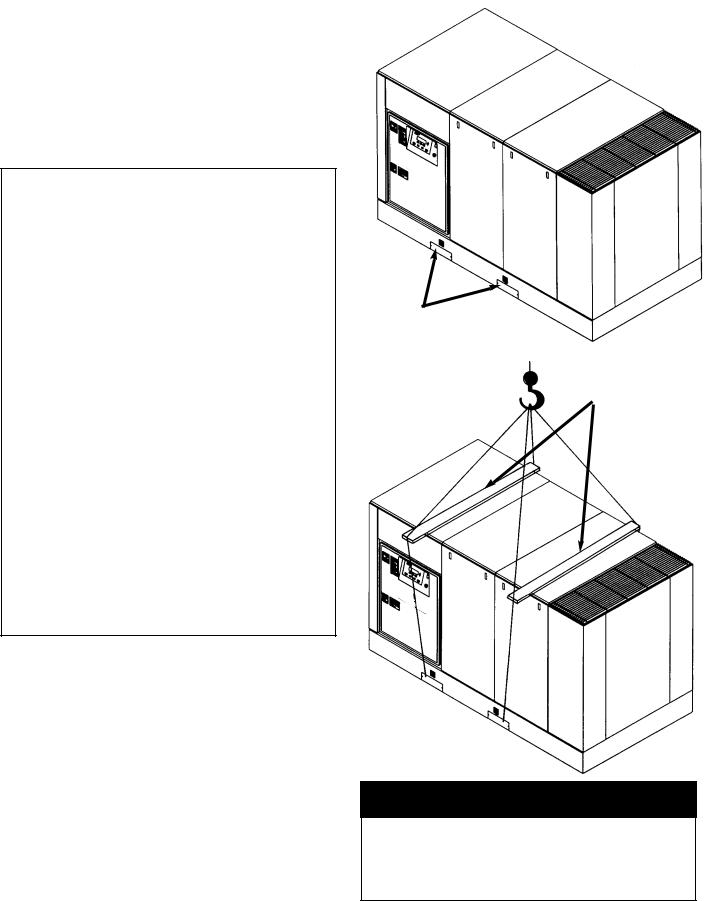
1.0RECEIPT OF EQUIPMENT
1.1INSPECTION
When you receive the compressor please inspect it closely. Any indication of careless handling by the carrier should be noted on the delivery receipt especially if the compressor will not be immediately uncrated. Obtaining the delivery man’s signed agreement to any noted damages will facilitate any future insurance claims.
IMPORTANT
READ THIS
LOST OR DAMAGED GOODS
THOROUGHLY INSPECT THIS SHIPMENT
IMMEDIATELY UPON ARRIVAL
OUR RESPONSIBILITY FOR THIS SHIPMENT CEASED WHEN THE CARRIER SIGNED BILL OF LADING
If goods are received short or in damaged condition, it is important that you notify the carrier and insist on a notation of the loss or damage across the face of the freight bill. Otherwise no claim can be enforced against the transportation company.
If concealed loss or damage is discovered, notify your carrier at once and request an inspection. This is absolutely necessary. Unless you do this the carrier will not entertain any claim for loss or damage. The agent will make an inspection and grant a concealed damage notation. If you give the transportation company a clear receipt for goods that have been damaged or lost in transit, you do so at your own risk and expense.
WE, AT I-R, ARE WILLING TO ASSIST YOU IN EVERY POSSIBLE MANNER TO COLLECT CLAIMS FOR LOSS OR DAMAGE, BUT THE WILLINGNESS ON OUR PART DOES NOT MAKE US RESPONSIBLE FOR COLLECTION OF CLAIMS OR REPLACEMENT OF MATERIAL. THE ACTUAL FILING AND PROCESSING OF THE CLAIM IS YOUR RESPONSIBILITY.
Ingersoll-Rand Company
Davidson, North Carolina
APDDGFO-99-79
1.2 UNPACKING AND HANDLING
The compressor package has been mounted on a base which provides for forklifting between the two side channels to facilitate handling during shipment. Care in positioning the forklifts is important because the location of the center of gravity is strongly affected by the location of the compression module and drive motor.
Slings can be used to lift the crates, but spreader bars must be used to prevent the slings from exerting a force against the sides of the crates.
1.3 TOOLS
Remove compressor unit from wooden skid. A crowbar and hammer will be needed.
FORKLIFT PADDING
WILL REDUCE SCRATCHES
AND MARS
SPREADER
BARS
IMPORTANT
Before starting this air compressor unit, the shipping brace(s) must be removed.
Save the brace(s) for future use.
See tag in unit.
8
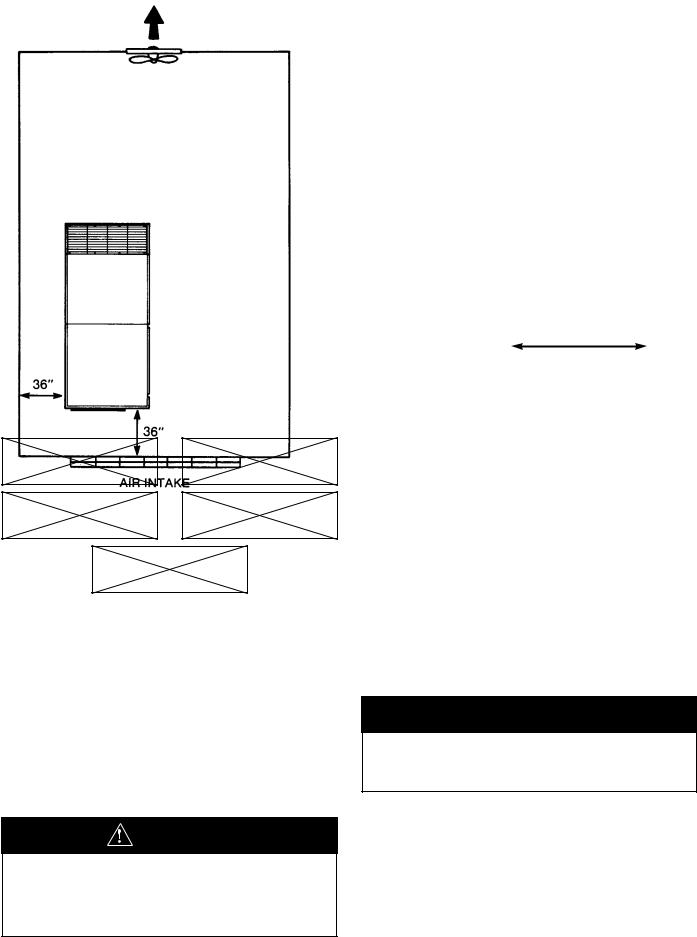
2.0INSTALLATION
2.1VENTILATION
Oil flooded rotary air compressors produce large amounts of heat. Because of this large heat production, the compressor must be placed in a room with adequate ventilation.
If heated air from the compressor exhaust is allowed to recirculate back to the compressor, the compressor will overheat and shut down. This heat must be exhausted from the room. You should take this into consideration when you decide where to place the compressor within your plant. Consider that the required maintenance clearance is 3 ft (.9 m) all around the compressor. However 42” (1.06m), or minimum required by latest NEC or applicable local codes, must be maintained in front of control panel.
Ambient temperatures higher than 115°F (46°C) should be avoided as well as areas of high humidity.
Consider also the environment surrounding or near the compressor. The area selected for the location of the compressor should be free of dust, chemicals, metal filings, paint fumes and overspray.
DUST |
CHEMICALS |
METAL |
PAINT |
FILINGS |
SPRAY |
42” (1.06m) OR 36” CODE MINIMUM
(.9 m)
36” (.9 m)
OVERSPRAY
2.2 FOUNDATION REQUIREMENTS
Refer to the foundation plan for the particular model compressor to be installed. See Section 8.0.
The compressor can be installed on any level floor that is capable of supporting it. Compressor weights are listed on the foundation plans.
When sound transmission is of particular importance it is often helpful to install a sheet of rubber-fabric-matting, or cork under the compressor to reduce the possibility of resonant sounds being transmitted or amplified through the floor.
NOTICE
Never elevate the compressor unit above the floor level. This may allow air to enter the cabinet under the base. Performance will be affected.
2.3 PIPING
The use of plastic bowls on line filters without metal guards can be hazardous. Their safety can be affected by either synthetic lubricants or the additives used in mineral oil. From a safety standpoint, metal bowls should be used on any pressurized system. Review of your plant air line system is recommended.
 WARNING
WARNING
Do not use plastic pipe, soldered copper fittings or rubber hose for discharge piping.
The built-in aftercooler reduces the discharge air temperature well below the dew point (for most ambient conditions), therefore, considerable water vapor is condensed. To remove this condensation, each compressor with built-in aftercooler is furnished with a combination condensate separator/trap.
9

2.3 PIPING (Continued)
A dripleg assembly and isolation valve should be mounted near the compressor discharge. A drain line should be connected to the condensate drain in the base.
IMPORTANT: The drain line must slope downward from the base to work properly.
NOTE: For ease of inspection of the automatic drain trap operation, the drain piping should include an open funnel.
It is possible that additional condensation can occur if the downstream piping cools the air even further and low points in the piping systems should be provided with driplegs and traps.
IMPORTANT: Discharge piping should be at least as large as the discharge connection at the compressor enclosure. All piping and fittings must be suitable for the maximum operating temperature of the unit and, at a minimum, rated for the same pressure as the compressor sump tank.
NOTICE
Do not use the compressor to support the discharge pipe.
Careful review of piping size from the compressor connection point is essential. Length of pipe, size of pipe, number and type of fittings and valves must be considered for optimum efficiency of your compressor.
It is essential when installing a new compressor to review the total plant air system. This is to ensure a safe and effective total system.
Liquid water occurs naturally in air lines as a result of compression. Moisture vapor in ambient air is concentrated when pressurized and condenses when cooled in downstream air piping.
Moisture in compressed air is responsible for costly problems in almost every application that relies on compressed air. Some common problems caused by moisture are rusting and scaling in pipelines, clogging of instruments, sticking of control valves, and freezing of outdoor compressed air lines. Any of these could result in partial or total plant shutdown.
Compressed air dryers reduce the water vapor concentration and prevent liquid water formation in compressed air lines. Dryers are a necessary companion to filters, aftercoolers, and automatic drains for improving the productivity of compressed air systems.
DISCHARGE PIPING WITH AFTERCOOLER
ROTARY-RECIP IN PARALLEL
200
160
Water/24ofGallons hours/1000acfm |
120 |
|
|
|
80 |
40
0 |
DEW POINT
|
|
|
|
|
|
|
|
|
|
|
|
|
|
|
|
|
|
|
|
without |
|
|
|
100°F/38°C |
|
|
|
35°F /1.7°C |
|
|
|
-40°F/-40°C |
|
|
|
|
Aftercooling |
|
|
|
(with |
|
|
|
(Refrigerated |
|
|
|
(Desiccant |
|
|
|
|
|
|
|
|||||||||||
|
|
|
|
|
|
|
Aftercooler) |
|
|
|
Dryer) |
|
|
|
Dryer) |
|
|
|
|
|
|
|
|
|
|
||||||||
|
|
|
|
|
|
|
|
|
|
|
|
|
|
|
|
|
|
|
|
|
|
|
|
|
|
|
|
|
|
|
|
|
|
|
|
|
|
|
|
|
|
|
|
|
|
|
|
|
|
|
MOISTURE CONTENT OF COMPRESSED AIR
10

Two types of dryers, refrigerated or desiccant, are used to correct moisture related problems in a compressed air system. Refrigerated dryers are normally specified where compressed air pressure dew points of 33°F (1°C) to 39°F (4°C) are adequate. Desiccant dryers are required where pressure dew points must be below 33°F (1°C).
Contact your local Ingersoll-Rand distributor for assistance in selecting correct Ingersoll-Rand filtration or drying products.
NOTE: Screw type compressors should not be installed in air systems with reciprocating compressors without a means of pulsation isolation, such as a common receiver tank. We recommend both types of compressor units be piped to a common receiver utilizing individual air lines.
When two rotary units are operated in parallel, provide an isolation valve and drain trap for each compressor before the common receiver.
2.4 ELECTRICAL INSTALLATION
Before proceeding further, we recommend that you review the safety data in the front of this manual.
Locate the compressor data plate on the side of the cooler box or end of the unit.
The data plate lists the rated operating pressure, the maximum discharge pressure and the electric motor characteristics and power.
Confirm that the line voltage and compressor nameplate voltage are the same and that the standard starter box meets the intent of NEMA 1 guidelines.
Open the starter box door. Confirm that all electrical connections are made and tightened. Confirm that the control transformer is wired correctly for supply voltage. See Figure 2.4-1 on next page for typical control transformer wiring.
PRESSURE
RELIEF
VALVE
PRESSURE
GAUGE
ROTARY TWO COMPRESSOR SYSTEM
Compressor Package Data
COMPRESSOR MODEL............................... |
m3/MIN |
CAPACITY...................................................... |
|
RATED OPERATING PRESSURE................. |
BARG |
MAX. DISCHARGE PRESSURE................... |
BARG |
MAX. MODULATE PRESSURE..................... |
BARG |
NOMINAL DRIVE MOTOR............................ |
KW |
NOMINAL FAN MOTOR................................ |
KW |
TOTAL PACKAGE AMPS...............................
VOLTS............................................................
PHASE / HERTZ............................................
CONTROL VOLTAGE.....................................
SERIAL NUMBER..........................................
CONTACTOR AMP. RATING.....................................
ASSEMBLY AMP. RATING........................................
LOCKED ROTOR AMP. RATING OF ASSY. ............
AIR SOLUTIONS GROUP
DAVIDSON, NORTH CAROLINA 28036 54425996 Rev.C
WWW.AIR.INGERSOLL-RAND.COM
54425996 Rev. C (75-160 KW)
Compressor Package Data
COMPRESSOR MODEL............................... |
CFM |
|
CAPACITY |
||
PSIG |
||
RATED OPERATING PRESSURE |
||
PSIG |
||
MAX. DISCHARGE PRESSURE |
||
PSIG |
||
MAX. MODULATE PRESSURE |
||
H.P. |
||
NOMINAL DRIVE MOTOR |
||
H.P. |
||
NOMINAL FAN MOTOR................................ |
TOTAL PACKAGE AMPS...............................
VOLTS............................................................
PHASE / HERTZ............................................
CONTROL VOLTAGE.....................................
SERIAL NUMBER..........................................
CONTACTOR AMP. RATING.....................................
ASSEMBLY AMP. RATING........................................
LOCKED ROTOR AMP. RATING OF ASSY. ............
AIR SOLUTIONS GROUP
DAVIDSON, NORTH CAROLINA 28036 39557095 Rev.05
WWW.AIR.INGERSOLL-RAND.COM
39557095 Rev.05 (100-200 HP)
11
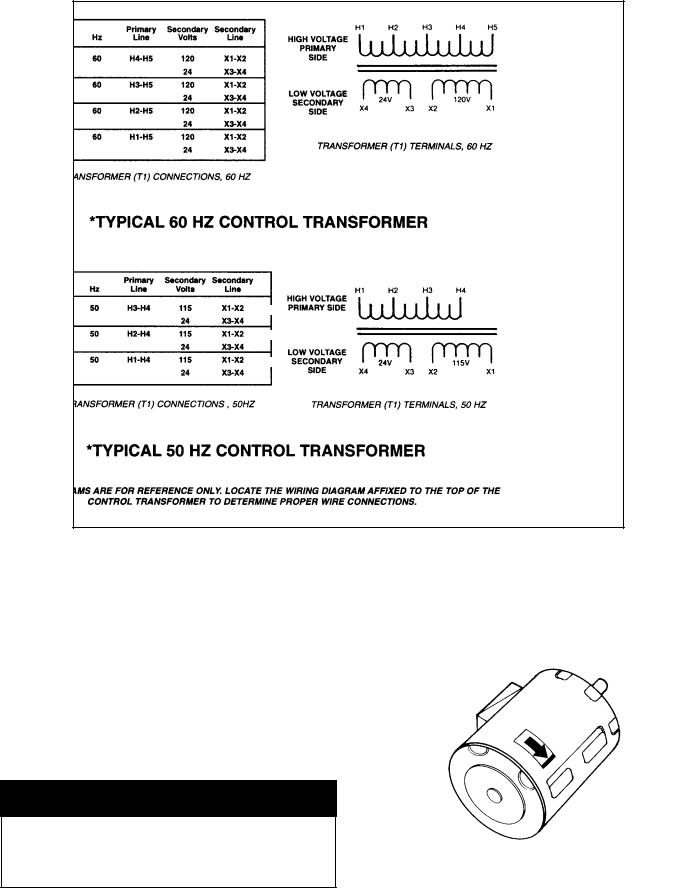
110
110
110
110V
FIGURE 2.4-1 TYPICAL CONTROL TRANSFORMER WIRING
ELECTRICAL INSTALLATION (Continued)
Inspect the motor and control wiring for tightness. Close and fasten the starter box door.
ROTATION CHECK
Locate the rotation decal on each motor.
DRIVE MOTOR
The correct compressor drive motor rotation is clockwise when viewed from the rear or non-drive end of the motor. See Figure 2.4-2.
 CAUTION
CAUTION
If the compressor is operated in the opposite direction of rotation, airend damage can result and is not warrantable.
DRIVE
END
NON-DRIVE
END
FIGURE 2.4-2 DRIVE MOTOR ROTATION
12
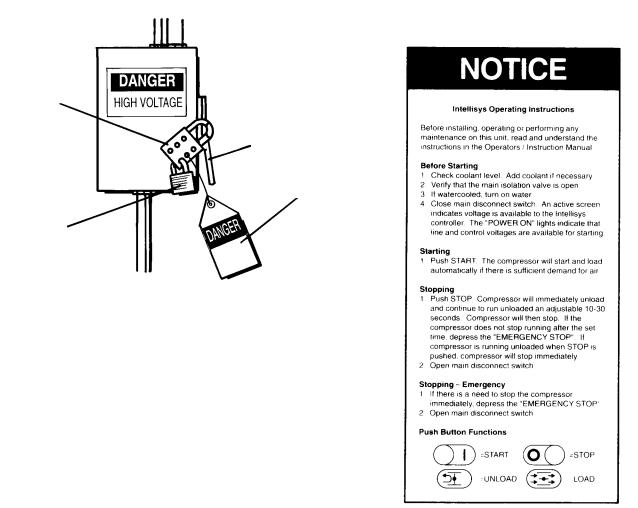
ELECTRICAL INSTALLATION (Continued)
The Intellisys will automatically shut the unit down if the compressor rotation is incorrect, and the display will indicate “CHECK MOTOR ROTATION” and will flash “ALARM”.
For the compressor motor rotation check, the motor jogging time must be as short as possible.
After depressing the start button, IMMEDIATELY depress the “EMERGENCY STOP” button. Should the motor rotation be incorrect, put main disconnect in the OFF position, lock and tag. See Figure 2.4-3.
HASP
LEVER
TAG
KEY
LOCK
FIGURE 2.4-3 MAIN DISCONNECT
LOCKED AND TAGGED
Open the starter box door.
Interchange any two line connections (L1, L2 or L3) at the starter. Close and fasten the starter box door. Recheck for correct rotation.
FAN MOTOR
Observe the compressor cooling fan. The rotation should be in accordance with the fan rotation decal affixed to the fan motor. Cooling air should exhaust through fan end of compressor enclosure.
Should the motor rotation not be correct, put the main disconnect in the OFF position, lock and tag.
Interchange any two fan motor leads at the fan motor manual starter (MMS). Close and fasten the starter box door. Recheck for correct rotation.
Fan motor rotation is clockwise when viewed from the fan motor side.
INTELLISYS OPERATING INSTRUCTIONS
Read and understand the following Intellisys Operating Instructions (See Figure 2.4-4) prior to operating the unit.
NOTE: These instructions are also contained on the decal near the Intellisys panel of the unit.
FIGURE 2.4-4 INTELLISYS
OPERATING INSTRUCTIONS
13
2.5 OUTDOOR SHELTERED INSTALLATION
Many times a compressor must be installed outside due to jobsite conditions or limited space within a manufacturing facility. When this occurs there are certain items that should be incorporated into the installation to help ensure trouble free operation. These items have been listed below plus Figure 2.5-1 has been included to show a typical outdoor sheltered installation. The unit must be purchased with the Outdoor Modification Option to provide NEMA 4 electrics and a cabinet exhaust on the end of the unit rather than the top to prevent recirculation of cooling air.
■The compressor should be on a concrete pad designed to drain water away. If the concrete pad is sloped, then the compressor must be leveled. In order to properly pull cooling air through the aftercooler, the base/skid must be sealed to the concrete pad.
■The roof of the shelter should extend a minimum of 4 ft (1.2 m) around all sides of the compressor to prevent direct rain and snow from falling on the unit.
■Air-cooled machines must be arranged under the shelter in a way that prevents air recirculation (i.e. hot exhaust back to the package inlet).
■If the installation includes more than one compressor, the hot air exhaust should not be directed towards the fresh air intake of the second unit or an Air Dryer.
■If a standard machine is to be installed outside, the ambient temperature must never drop below 35°F (1.7°C).
■If ambient temperature drops below 35°F (1.7°C) to as low as –10°F (–23°C) the unit must be supplied with the Low Ambient Option. Installations below –10°F (–23°C) ambient are not recommended. The Low Ambient Option requires a separate power source to operate internal heaters.
■Arrange the machine with the Intellisys controller/starter enclosure facing away from the sun as radiant heat can affect starter/lntellisys performance. Also direct sunlight and UV rays will degrade the membrane touch panel. This is not a warrantable situation.
■Power disconnect switch should be within line of sight and in close proximity to the unit. N.E.C. and local electrical codes must be followed when installing the power disconnect switch.
■Condensate drains must never be allowed to dump on the ground. Run to a suitable sump for future collection and disposal or separation of lubricant and water mixture.
■Incoming power connections must use suitable connectors for outdoor weather tight service.
■A minimum of 3 ft (.9 m) clearance must be allowed on all four sides of the unit for service access. If possible, access by a forklift and/or an overhead beam hoist should be kept in mind (for eventual service to airend or motor).
■If the area around the installation contains fine airborne dust or lint and fibers etc., then the unit should be purchased with the High Dust Filter Option and TEFC motors.
■If larger debris, such as leaves or trash, are blowing in the area, the Inlet Panel Filter Accessory should be purchased and added to the unit (ship loose item).
■Some type of protection such as a fence or security system, should be provided to prevent unauthorized access.
14
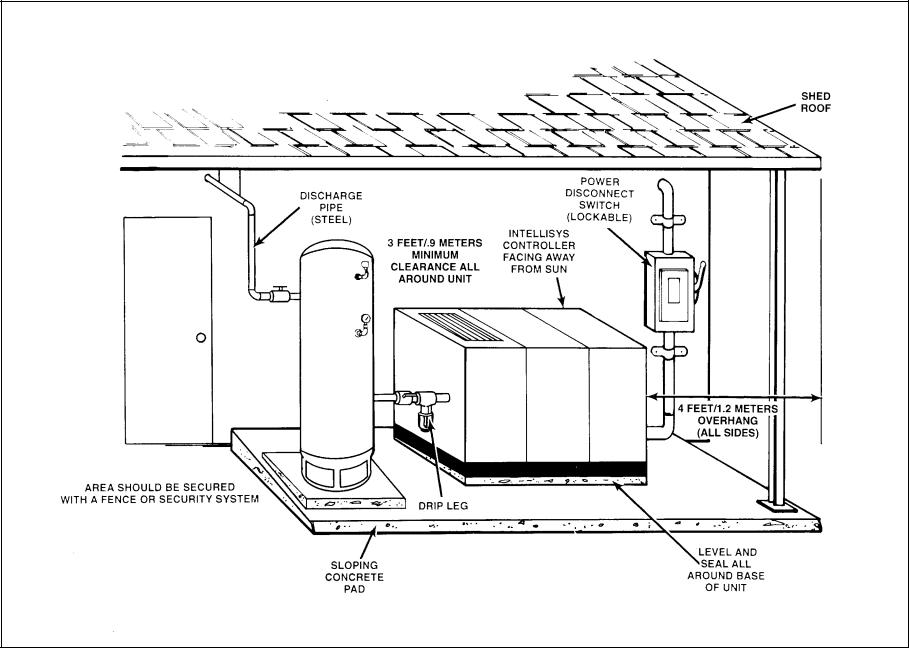
FIGURE 2.5-1 TYPICAL OUTDOOR SHELTERED INSTALLATION
15
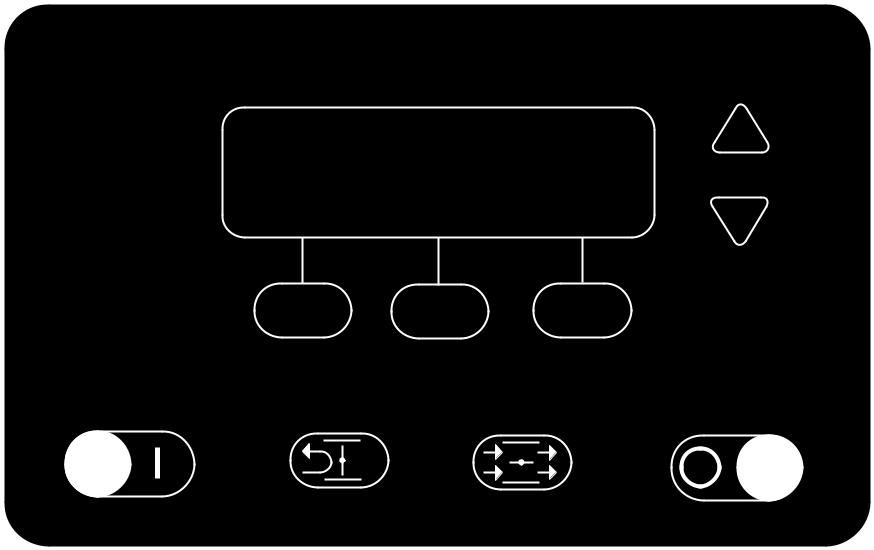
16
INGERSOLLrAND
INTELLISYS
INTELLISYS 0.3
INTELLISYS CONTROLLER
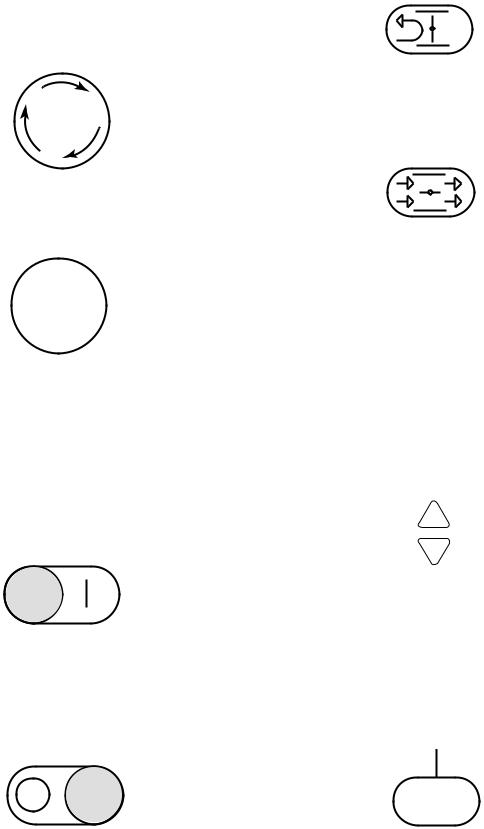
3.0INTELLISYS
3.1INTELLISYS CONTROLS
EMERGENCY STOP
Pressing this switch stops the compressor immediately. The compressor can not be restarted until the switch is manually reset. Turn the switch knob clockwise to reset.
EMEG
STOP
POWER ON LIGHT
This indicates the control voltage and the line voltage are available for starting.
POWER
ON
The operator panel is divided into two areas. The bottom row of four buttons provides direct control over the starting, stopping, unloading and loading of the compressor. These are defined by the symbols printed on the buttons themselves, as shown here.
START
Pressing this button will start the compressor if the display shows “Ready To Start”. The compressor will start and load if there is sufficient demand for air.
STOP
Pressing this button will activate the unloaded stop sequence. If the compressor is running loaded, it will unload and continue to run unloaded for an adjustable 10 to 30 seconds and then stop. If the compressor is running unloaded, it will stop immediately.
UNLOAD
Pressing this button will cause the compressor to unload and remain unloaded. The display will indicate the machine is “Running Unloaded”, and “Mode: UNLOAD”.
LOAD
Pressing this button will cause the compressor to load if the compressor is running and if the “Discharge Pressure” is less than the “Online Pressure”. This also returns the machine to the operating mode that is specified by the “Mode of Operation” set point.
The other five buttons provide access to various operator-selectable functions and machine operating conditions. The purpose of each of these buttons is defined by the display screen and the particular function being performed at that time.
ARROWS
These up and down buttons have multiple functions relating to the right half of the display screen. When lists are presented, the buttons are used to move up or down through the items on the list. The small arrow(s) displayed in the upper right corner of the display screen indicate when you can move up (designated by arrow head pointing up) and/or down (designated by arrow head pointing down) through the list.
When the value of a specific machine operating parameter is highlighted on the display screen for the purpose of changing that value, the buttons are used to change the value itself.
DISPLAY BUTTONS
The functions of the three buttons below the display screen change and are defined by the words immediately above them in the bottom line of the screen. Each function, such as MAIN MENU, STATUS, SET, etc., is described in appropriate sections in this manual.
17
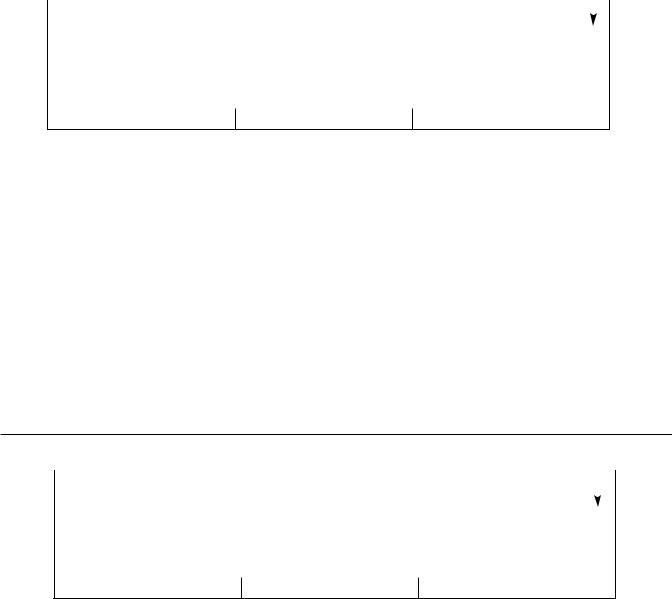
3.2 DISPLAY SCREEN
|
|
|
|
|
|
|
|
|
|
|
|
|
|
|
|
|
|
|
- CURRENT STATUS- |
|
|
|
|
|
|
|
|
|
|
|
|
|
|
|
|
|
|
|
|
|
Package Discharge Temp |
|
|
|
|
1 0 0 |
|
|
|
|
|
|
||
|
|
|
|
|
|
|
103°F |
|
|
|
|
|
|
P S I |
|
|
|||||
|
|
|
|
|
|
|
|
|
|
|
|
|
|
|
|
|
|
|
|
|
|
|
Running Loaded |
|
|
|
|
|
Airend Discharge Temp |
|
|
|
|
Mode: MOD/ACS |
|
|
|
|
|
193°F |
|
|
|
|
|
|
|
|
|
|
|
|
|
|
|
|
|
|
|
|
|
|
|
|
|
|
|
|
|
|
|
|
|
|
|
|
MAIN MENU
The display screen is divided into three functional areas, as seen in the typical CURRENT STATUS screen shown here.
The left side continuously shows the package discharge pressure in large numbers, with the line directly below the numbers showing the running condition of the machine, and the line below that showing the present mode of operation.
The right side shows various items or lists such as the machine’s CURRENT STATUS readings, the MAIN MENU, the OPERATOR SETPOINTS list, etc. Any of the lists can be moved up or down by pressing the arrow buttons to the right of the screen. The small arrow(s) displayed in the upper right corner of the screen indicate when you can move up (designated by
arrow head pointing up) and/or down (designated by arrow head pointing down) through a list. The arrow buttons are also used to change an individual item’s value. At certain times, items and/or their values are “highlighted”. This means they are displayed as light characters on a dark background.
The bottom of the screen is divided into thirds with the words in each small box showing the function of the button directly beneath it. The words will change in these boxes depending on what actions are permitted at any particular time. The action resulting from pressing each of these buttons is indicated in Figure 3.2.1, which can be used as a quick reference of how to step the controller screen through any desired function.
3.3 CURRENT STATUS
|
|
|
|
|
|
|
|
|
|
|
|
|
|
|
|
|
|
|
-CURRENT STATUS- |
|
|
|
|
|
|
|
|
|
|
|
|
|
|
|
|
|
|
|
|
|
Package Discharge Temp |
|
|
|
|
1 0 0 |
|
|
|
|
|
|
|
|
|
|
|
|
|
|
|
103°F |
|
|
|
|
|
|
P S I |
|
|
|||||
|
|
|
|
|
|
|
|
|
|
|
|
|
|
|
|
|
|
|
|
|
|
|
Running Loaded |
|
|
|
|
|
Airend Discharge Temp |
|
|
|
|
Mode: MOD/ACS |
|
|
|
|
|
193°F |
|
|
|
|
|
|
|
|
|
|
|
|
|
|
|
|
|
|
|
|
|
|
|
|
|
MAIN MENU
The CURRENT STATUS screen is considered the “normal” display that the controller shows.
The following items and their present values can be displayed on the right side of the screen by pressing the up and down arrow buttons.
CURRENT STATUS Items |
|
Discharge Temperature |
Inlet Vacuum |
Airend Discharge Temperature |
Inlet Filter |
Injected Temperature |
Total Hours |
Sump Pressure |
Loaded Hours |
Separator Pressure Drop |
% Load Modulation |
|
Unloaded Inlet Vacuum |
|
Coolant Pressure |
|
Time & Date |
Coolant Filter |
Software Title |
|
and Version |
The controller automatically returns the display to this CURRENT STATUS screen from other screens if no buttons are pressed within 30 seconds.
The MAIN MENU screen can be accessed from the CURRENT STATUS screen by pressing the MAIN MENU button, identified by the words “MAIN MENU” in the bottom line of the screen directly above the center button.
18
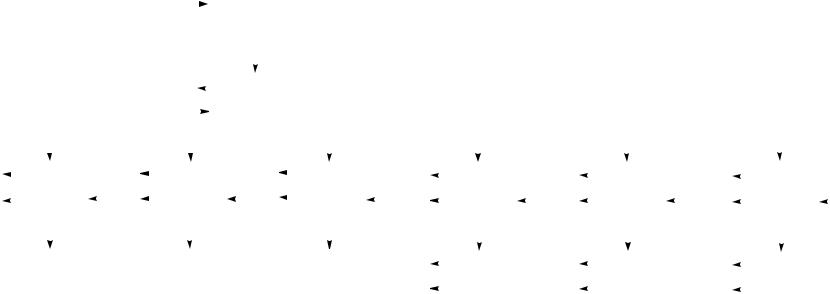
Flow Panel Operator 1.2.3 Figure |
INTELLISYS |
Diagram |
|
|
|
|
|
|
|
|
|
|
“Status” |
|
|
|
|
CURRENT STATUS |
|
|
|
|
|
|
|
|
|
|
|
|
|
|
|
|
|
|
|
|
|
|
|
|
|
||||||
|
|
|
|
|
|
|
|
|
|
|
|
|
|
|
|
|
|
|
|
|
|
|
|
|
|
|
|
|
|
|
|
|
|
|
|
|
|
||||||||
|
|
|
|
|
|
|
|
|
|
|
|
|
|
|
|
|
|
|
|
|
|
|
|
|
|
|
|
|
|
|
|
|
|
|
|
|
|
|
|
|
|
|
|
|
|
|
|
|
|
|
|
|
|
|
|
|
|
|
|
|
|
|
|
“Main Menu” |
|
|
|
|
|
|
|
|
|
|
|
|
|
|
|
|
|
|
|
|
|
|
|
||||
|
|
|
|
|
|
|
|
|
“Status” |
|
|
|
|
|
|
|
|
|
|
|
|
|
|
|
|
|
|
|
|
|
|
|
|
|
|
|
|
|
|
|
|
|
|
||
|
|
|
|
|
|
|
|
|
|
|
|
|
|
|
|
|
|
|
|
|
|
|
|
|
|
|
|
|
|
|
|
|
|
|
|
|
|
|
|
|
|
|
|||
|
|
|
|
|
|
|
|
|
|
|
|
MAIN MENU* |
|
|
|
|
|
|
|
|
|
|
|
|
|
|
|
|
|
|
|
|
|
|
|
|
|
|
|||||||
|
|
|
|
|
|
|
|
|
|
|
|
|
|
|
|
|
|
|
|
|
|
|
|
|
|
|
|
|
|
|
|
|
|
|
|
|
|
||||||||
|
|
|
|
|
|
|
|
|
|
|
|
|
|
|
|
|
|
|
|
|
|
|
|
|
|
|
|
|
|
|
|
|
|
|
|
|
|
|
|
|
|||||
|
|
|
|
|
|
|
|
“Main Menu” |
|
|
|
|
|
|
|
|
|
|
|
|
|
|
|
|
|
|
|
|
|
|
|
|
|
|
|
|
|
|
|
|
|
|
|
||
|
|
|
|
|
|
|
|
|
|
|
|
|
|
|
|
|
|
|
|
|
|
|
|
|
|
|
|
|
|
|
|
|
|
|
|
|
|
|
|
|
|
|
|||
|
|
|
|
|
|
|
|
|
|
|
|
|
|
|
|
|
|
|
|
|
|
|
|
|
|
|
|
|
|
|
|
|
|
|
|
|
|
|
|
|
|
|
|
|
|
|
|
|
|
|
|
|
|
|
|
|
|
|
|
|
|
|
|
“Select” |
|
|
|
|
|
|
|
|
|
|
|
|
|
|
|
|
|
|
|
|
|
|
|
||||
|
|
|
|
|
|
|
|
|
|
|
|
|
|
|
|
|
|
|
|
|
|
|
|
|
|
|
|
|
|
|
|
|
|
|
|
|
|
|
|
|
|
|
|
|
|
“Main Menu” |
|
|
|
“Main Menu” |
|
|
|
|
|
|
|
“Main Menu” |
|
|
|
|
|
|
“Main Menu” |
|
|
|
|
|
“Main Menu” |
|
|
|
|
|
|
|
“Main Menu” |
|
|
|
|
|
|
||||||
|
|
|
|
|
|
|
|
|
|
|
|
|
|
|
|
|
|
|
|
|
|
|
|
|
|
|
|
|
|
|
|
|
|
||||||||||||
|
OPERATOR |
|
OPTIONS** |
|
|
SENSOR |
|
|
|
ALARM |
|
|
|
CLOCK |
|
|
|
|
INTEGRAL |
|
|
||||||||||||||||||||||||
|
|
|
|
|
|
|
|
|
|
|
|
|
|
|
|
|
|
|
|
|
|
|
|
|
|
|
|
||||||||||||||||||
|
|
|
SETPOINTS** |
|
|
|
|
|
|
|
|
|
CALIBRATION** |
|
|
|
|
HISTORY** |
|
|
|
|
FUNCTIONS |
|
|
|
|
|
SEQUENCING |
|
|
||||||||||||||
“Status” |
|
|
|
|
“Status” |
|
|
|
|
|
|
|
|
|
“Status” |
|
|
|
“Status” |
|
|
|
“Status” |
|
|
|
|
“Status” |
|
|
|
||||||||||||||
|
|
|
|
|
|
|
|
|
|
|
|
|
|
|
|
|
|
|
|
|
|
|
|
|
|
|
|
|
|
|
|
|
|
|
|
|
|
|
|
|
|
|
|
||
|
|
|
“Select” |
|
|
|
|
|
“Select” |
|
|
|
|
|
|
|
|
|
|
“Select” |
|
|
|
|
“Select” |
|
|
|
|
“Select” |
|
|
|
|
|
|
“Select” |
|
|
||||||
|
|
|
|
|
|
|
|
|
|
|
|
|
|
|
|
|
|
|
|
|
|
|
|
|
|
|
|
|
|
|
|
|
|
|
|
|
|
|
|
|
|
|
|
|
|
|
|
|
|
|
|
|
|
|
|
|
|
|
|
|
|
|
|
|
|
|
|
|
|
|
|
|
|
|
|
|
|
|
|
|
|
|
|
|
|
|
|
|
|
|
|
|
|
|
OPERATOR |
|
|
|
|
OPTIONS |
|
|
|
|
|
|
SENSOR |
|
|
“Main Menu” |
|
ALARM |
|
|
“Main Menu” |
|
DATE AND |
|
|
|
“Main Menu” |
|
INTEGRAL |
|
|
||||||||||||
|
|
|
|
|
|
|
|
|
|
|
|
|
|
|
|
|
|
|
|
|
|
|
|
|
|||||||||||||||||||||
|
|
|
SETPOINTS |
|
|
|
|
|
|
|
|
|
CALIBRATION |
|
|
|
|
HISTORY |
|
|
|
|
|
|
|
|
|
SEQUENCING |
|
|
|||||||||||||||
|
|
|
|
|
|
|
ITEM*** |
|
|
|
|
|
|
|
|
|
|
|
|
|
TIME |
|
|
|
|
|
|
|
|||||||||||||||||
|
|
|
ITEM*** |
|
|
|
|
|
|
|
|
|
|
ITEM**** |
|
|
“Status” |
|
ITEM***** |
|
|
“Status” |
|
|
|
|
“Status” |
|
|
ITEM*** |
|
|
|||||||||||||
|
|
|
|
|
|
|
|
|
|
|
|
|
|
|
|
|
|
|
|
|
|
|
|
|
|
|
|
|
|
|
|
|
|
|
|||||||||||
|
|
|
|
|
|
|
|
|
|
|
|
|
|
|
|
|
|
|
|
|
|
|
|
|
|
|
|
|
|
|
|
|
|
|
|
|
|||||||||
|
|
|
|
|
|
|
|
|
|
|
|
|
|
|
|
|
|
|
|
|
|
|
|
|
|
|
|
|
|
|
|
|
|
|
|
|
|
|
|
|
|
|
|
|
|
|
|
|
|
|
|
|
|
|
|
|
|
|
|
|
|
|
|
|
|
|
|
|
|
|
|
|
|
|
|
|
|
|
|
|
|
|
|
|
|
|
|
|
|
|
|
|
|
|
|
“Cancel” or “Set” |
“Cancel” or “Set” |
|
“Cancel” or “Calibrate” |
|
|
“Alarm Hist. |
|
|
“ |
|
ot Set |
|
“ |
|
ot Set |
||||||||||||||||||||||||||
|
|
|
|
|
|
|
|
|
|
|
|
“Cancel” or “set” |
|||||||||||||||||||||||||||||||||
|
|
|
|
|
|
|
|
|
|
|
|
|
|
|
|
|
|
|
|
|
|
|
|
|
|
|
|
“Cancel” or “Set” |
|
|
|
“Cancel” or “set” |
|
|
|
|
|
|
|||||||
NOTE - Use the UP and DOWN arrows to move between selections. Items will be highlighted in inverse display mode.
*- Selecting the highlighted item will display the corresponding menu.
**- Selecting the highlighted item will place the value in edit mode. This is indicated by only the value being displayed in inverse display mode.
***- The UP and DOWN arrows will alter the value. Depressing “Cancel” will exit the edit mode and leave the value unchanged. Depressing “Set” will save the new value and flash the value to indicate acceptance.
****- Depressing “Cancel” will exit calibration mode. Depressing “Calibrate” will calibrate selected sensor.
*****- Use UP and DOWN arrows to scroll through list of status items.
19
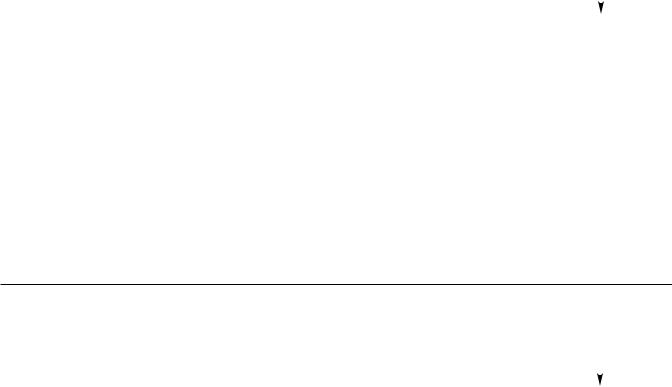
3.4 MAIN MENU
|
|
|
|
|
|
|
|
|
|
|
-MAIN MENU- |
|
|
|||
|
|
|
|
|
|
|
|
|
|
|
|
|||||
|
|
|
|
|
|
|
|
|
|
|
Operator Setpoints |
|||||
|
|
|
1 0 0 |
|
|
|
|
|
|
|||||||
|
|
|
|
|
|
|
|
|
|
Options |
||||||
|
|
|
|
P S I |
||||||||||||
|
|
|
|
|
|
|
|
|
|
|
Sensor Calibration |
|||||
|
|
|
|
|
|
|
|
|
|
|||||||
|
|
|
Ready To Start |
|
|
Alarm History |
||||||||||
|
|
|
|
|
|
|
|
|
|
|
Clock Functions |
|||||
|
|
|
|
|
|
|
|
|
|
|
||||||
|
|
|
|
|
|
|
|
|
|
|
|
|
|
|
|
|
|
|
|
STATUS |
|
|
|
|
|
|
|
|
|
SELECT |
|
|
|
|
|
|
|
|
|
|
|
|
|
|
|
|
|
|
|
|
The MAIN MENU screen is the point from which various operator functions can be accessed. Refer to the reference diagram in Figure 3.2.1.
Each of the functions can be chosen by using the up and down arrows to highlight it on the screen.
The controller will go to the highlighted function if the SELECT button is pressed or will return to the CURRENT STATUS screen if the STATUS button is pressed.
3.5 OPERATOR SETPOINTS
|
|
|
|
|
|
|
|
|
|
|
|
-OPERATOR SETPOINTS- |
|
|
||||
|
|
|
|
|
|
|
|
|
|
|
|
|
||||||
|
|
|
|
|
|
|
|
|
|
|
|
|
|
|
|
|
|
|
|
|
|
1 0 0 |
|
|
|
|
|
|
|
|
Offline Pressure |
||||||
|
|
|
|
P S I |
|
|
|
|||||||||||
|
|
|
|
|
|
|
|
|
103 PSI |
|||||||||
|
|
|
|
|
|
|
|
|
|
|
|
Online Pressure |
||||||
|
|
|
Ready To Start |
|
|
|||||||||||||
|
|
|
|
|
|
|
|
93 PSI |
||||||||||
|
|
|
|
|
|
|
|
|
|
|
|
|
|
|
||||
|
|
|
|
|
|
|
|
|
|
|
|
|
|
|
|
|
|
|
|
|
|
STATUS |
|
|
|
|
|
|
MAIN MENU |
|
|
|
SELECT |
|
|
|
|
|
|
|
|
|
|
|
|
|
|
|
|
|
|
|
|
|
|
|
Setpoints are user-adjustable variables in the controller logic that can be set using the OPERATOR SETPOINTS screen.
The name and value of each of the setpoints listed below can be seen on the screen by moving the list up and down using the arrow buttons.
OPERATOR SETPOINTS |
RANGE |
STEP |
UNIT |
Lead/Lag |
Lead or Lag |
--- |
--- |
Offline Pressure |
75 to RATED +3 |
1 |
PSIG |
Online Pressure |
65 to OFFLINE - 10 |
1 |
PSIG |
Lag Offset |
0 to 45 |
1 |
PSIG |
Mode of Operation |
MOD/ACS, ON/OFF LINE, --- |
--- |
|
|
MODULATION ONLY |
|
|
Max Modulation Pressure |
Online + 10 to Offline + 7 |
1 |
PSIG |
Stop Delay Time |
10 to 60 |
1 |
SEC |
Star-Delta Time* |
5 to 20 |
1 |
SEC |
(Screen) Contrast |
0 to 10 |
1 |
--- |
* Does not apply to automatic across the line starters.
Setpoints associated with options are described in the OPTIONS Section 3.6.
A setpoint’s value can be changed by first highlighting the item and its value and pressing the SELECT button to highlight just the value. When the value line is highlighted by itself, the value can be adjusted using the up and down arrow buttons. The CANCEL and SET buttons appear at this time. Press the SET button to enter the new value, or press the CANCEL button to return to the value of the setpoint prior to using the arrows. The displayed value will flash twice to indicate it has been entered into the setpoint, and the pair of setpoint item and value display lines will again be highlighted together.
Operator set points can be exited by pressing the STATUS or MAIN MENU buttons. If no buttons are pressed within 30 seconds, the display will return to the CURRENT STATUS screen.
20

3.5.1Lead/Lag- This setpoint is used for setting lead or lag operation. If set to lead, the controller will load and unload the compressor by the online and offline setpoints. If set to lag, the controller will subtract the lag offset (see 3.5.4) from the online and offline set points and operate the compressor at the lower pressure range.
3.5.2Offline Pressure- This setpoint is the pressure the compressor will unload at if it is operating in on/off line mode.
3.5.3Online Pressure- This setpoint is the pressure the compressor will load at.
3.5.4Lag Offset- This setpoint is used with the lead/lag operation. If the lead/lag set point is set to lag (see 3.5.1), the value of the lag offset will be subtracted from the online and offline setpoints.
3.5.5Mode of Operation- This setpoint is used to select the operating mode of the compressor. The choices are MOD/ACS, ON/OFF LINE, and MODULATION ONLY. See section 5.8 for more information on these operating modes.
3.5.6Max Modulation Pressure- This setpoint is the pressure the compressor will unload at if it is modulating. As the package discharge pressure rises toward this value, the inlet valve will start to close. The compressor will unload once the package discharge reaches this value. See section 5.8 for more information on modulation.
3.5.7Stop Delay Time- This setpoint is the minimum amount of time the compressor will run unloaded before stopping. This period does not apply to alarms (shutdowns).
3.5.8Star-Delta Time- This setpoint is only used with star-delta starters. It is not used if the starter is full voltage or a remote starter. This is the time period between starting and star-delta transition.
3.5.9Contrast- This setpoint is used to improve the display on the Intellisys.
3.6 OPTIONS
|
|
|
|
|
|
|
|
|
|
|
|
-OPTIONS- |
|
|
|||
|
|
|
|
|
|
|
|
|
|
|
|
|
|||||
|
|
|
|
|
|
|
|
|
|
|
|
|
|
|
|
|
|
|
|
|
1 0 0 |
|
|
|
|
|
|
|
|
Auto Restart |
|||||
|
|
|
|
P S I |
|
|
|
|
Off |
||||||||
|
|
|
|
|
|
|
|
|
|
|
|
Auto Restart Time |
|||||
|
|
|
|
|
|
||||||||||||
|
|
|
Ready To Start |
|
|||||||||||||
|
|
|
|
|
|
|
|
|
|
|
|
10 MINUTES |
|||||
|
|
|
|
|
|
|
|
|
|
|
|
||||||
|
|
|
|
|
|
|
|
|
|
|
|
|
|
|
|
|
|
|
|
|
STATUS |
|
|
|
|
|
|
MAIN MENU |
|
|
SELECT |
|
|
|
|
|
|
|
|
|
|
|
|
|
|
|
|
|
|
|
|
|
|
Options are turned on or off and their associated values are set using the OPTION screen.
Some options require additional machine hardware and the proper “Option Module” to plug into the Intellisys controller. Descriptions of the options operations are in Section 7.0. The name and value of each of the options listed in the right hand column can be seen by moving the list up and down using the arrow buttons.
An Option item’s value can be changed the same way OPERATOR SETPOINTS values are changed. See Section 3.5 for an explanation.
OPTIONS ITEMS |
RANGE |
STEP |
UNIT |
Auto Restart |
On/Off |
--- |
--- |
Auto Restart Time |
2 to 60 |
1 |
MIN |
Auto Restart Delay Time |
0 to 60 |
1 |
SEC |
Sequencer |
On/Off |
--- |
--- |
Remote Start/Stop |
On/Off |
--- |
--- |
Power Out Restart |
On/Off |
--- |
--- |
Power Out Restart Time |
10 to 600 |
1 |
SEC |
Low Ambient |
On/Off |
--- |
--- |
Min. Cooler Out Temp |
30 to 150 |
1 |
Deg. F |
Separator Delta-P Solenoid |
On/Off |
--- |
--- |
Separator Delta-P Sensor |
On/Off |
--- |
--- |
Lead/Lag Cycle Length |
0-750 |
1 |
HRS |
Scheduled Start |
00:00 to 23:59 |
1 |
TIME |
Scheduled Stop |
00:00 to 23:59 |
1 |
TIME |
High Dust Filter |
On/Off |
--- |
--- |
Modbus Protocol |
On/Off/ICU |
--- |
--- |
Modbus Address |
1 to 247 |
1 |
--- |
21
3.6 OPTIONS (CONTINUED)
3.6.1Auto Restart- This setpoint is used to enable or disable the auto restart option.
3.6.2Auto Restart Time- This setpoint is the minimum time period the compressor must run unloaded before it can stop in the auto restart mode.
3.6.3Auto Restart Delay Time- If the compressor is stopped in auto restart, this setpoint is the number of seconds the package discharge pressure must remain below the online pressure setpoint before the compressor will restart.
3.6.4Sequencer- This setpoint is used to enable or disable sequencer operation.
3.6.5Remote Start/Stpop- This setpoint is used to enable or disable the remote start/stop option.
3.6.6Power Out Restart- This setpoint is used to enable or disable the power out restart option, if it is installed.
3.7.7 Power Out Restart Time- If the power out restart option is installed and enabled, this setpoint is time period between power returning to the compressor and the compressor starting.
3.6.8Low Ambient- This setpoint enables or disables the low ambient option. If the low ambient option is enabled, sensor 3CTT must be installed in the compressor.
3.6.9Minimum Cooler Out Temperature- When the low ambient option is installed, this setpoint is the minimum temperature to which the coolant must rise before the compressor will load.
3.6.10Separator Delta-P Solenoid- This setpoint enables or disables the separator delta-p solenoid option. Enabling this option will automatically disable the Separator Delta-P Sensor option.
3.6.11Separator Delta-P Sensor- This setpoint enables or disables the separator delta-p sensor option. Enabling this option will automatically disable the Separator Delta-P Solenoid option.
3.6.12Lead/Lag Cycle Length- This setpoint enables the automatic cycling between lead and lag operation. If it is set to a value greater than 0, the controller will cycle between lead and lag operation. The value of this set point is the cycle length in real time hours. A value of 0 will disable the automatic cycling between lead and lag.
3.6.13Scheduled Start- If the scheduled start/stop option is installed, this set point is the time of the day (hour and minute) that the compressor will automatically start. To disable this option, set it to the same value as the scheduled stop (section 3.6.14).
3.6.14Scheduled Stop- If the scheduled start/stop option is installed, this setpoint is the time of the day (hour and minute) that the compressor will automatically stop. To disable this option, set it to the same value as the scheduled start (section 3.6.13).
3.6.15High Dust Filter- This option enables or disables the high dust filter operation.
3.6.16Modbus Protocol- This option is for IngersollRand service use only.
3.6.17Modbus Address- This feature is used with the Modbus Protocol and is for Ingersoll-Rand service use only.
22

3.7 SENSOR CALIBRATION
|
|
|
|
|
|
|
|
|
|
|
|
|
|
-SENSOR CALIBRATION- |
|
|
||||
|
|
|
|
|
|
|
|
|
|
|
|
|
|
|
||||||
|
|
|
|
|
|
|
|
|
|
|
|
|
|
|
|
|
|
|
|
|
|
|
|
|
1 0 00 |
|
|
|
|
|
|
|
|
|
|
Sensor 1AVPT |
|||||
|
|
|
|
|
|
P S I |
|
|
|
|
CALIBRATE |
|||||||||
|
|
|
|
|
|
|
|
|
|
|
|
|
|
|
Sensor 3APT |
|||||
|
|
|
|
|
|
|
|
|
||||||||||||
|
|
|
|
Ready To Start |
|
|
||||||||||||||
|
|
|
|
|
|
|
|
|
|
|
|
|
|
|
CALIBRATE |
|||||
|
|
|
|
|
|
|
|
|
|
|
|
|
|
|
||||||
|
|
|
|
|
|
|
|
|
|
|
|
|
|
|
|
|
|
|
|
|
|
|
|
|
STATUS |
|
|
|
|
|
|
MAIN MENU |
|
|
|
SELECT |
|
|
|
||
|
|
|
|
|
|
|
|
|
|
|
|
|
|
|
|
|
|
|
|
|
Pressure sensor calibration is done through the SENSOR CALIBRATION screen. Sensor calibration can only take place when the machine is stopped. Calibration needs to be done only after a sensor has been replaced or the Intellisys controller has been replaced.
Each of the sensors listed below can be chosen by using the up and down arrow buttons to highlight it on the screen.
Select the highlighted sensor by pressing the SELECT button. Press the CALIBRATE button to start the automatic calibration procedure, or press the CANCEL button to not calibrate it and return to the sensor list.
The calibration screen can be exited by pressing either the STATUS or MAIN MENU buttons. If no buttons are pressed within 30 seconds, the display will return to the CURRENT STATUS screen.
SENSOR CALIBRATION Items
Sensor 1AVPT
Sensor 3APT
Sensor 4APT
Sensor 5CPT
Sensor 6APT
3.8 ALARM HISTORY
|
|
|
|
|
|
|
|
|
|
|
|
|
-ALARM HISTORY- |
|
|||
|
|
|
|
|
|
|
|
|
|
|
|
|
|
|
|
|
|
|
|
|
1 0 0 |
|
|
|
|
|
|
|
|
|
Alarm History 1 |
||||
|
|
|
|
P S I |
|
|
|
MOTOR OVERLOAD |
|||||||||
|
|
|
|
|
|
|
|
|
|
|
|
|
Alarm History 2 |
||||
|
|
|
|
|
|
|
|
||||||||||
|
|
|
Ready To Start |
|
|
|
|
||||||||||
|
|
|
|
|
|
|
|
|
|
|
|
HIGH AIREND DISCH TEMP |
|||||
|
|
|
|
|
|
|
|
|
|
|
|
||||||
|
|
|
|
|
|
|
|
|
|
|
|
|
|
|
|
|
|
|
|
|
STATUS |
|
|
|
|
|
|
MAIN MENU |
|
|
|
SELECT |
|
|
|
|
|
|
|
|
|
|
|
|
|
|
|
|
|
|
|
|
|
|
|
|
|
|
|
|
|
|
|
|
|
|
|
|
|
|
|
|
|
|
|
|
|
|
|
|
|
|
|
|
|
|
|
|
|
Alarm History displays each of the Alarm messages for the last 15 Alarms experienced by the machine. It also gives access to displaying the machine operating conditions that existed at the time of each Alarm. The first one shown, “Alarm History 1”, was the most recent Alarm to occur. Note that multiple, consecutive EMERGENCY STOP Alarms are not recorded as separate Alarms, only the first one will be shown.
Each of the last 15 Alarm messages can be seen by moving the Alarm History list up and down using the arrow buttons. Pressing the SELECT button when one of the Alarms is highlighted will display the list of machine values that existed at the time that particular Alarm occurred.
23
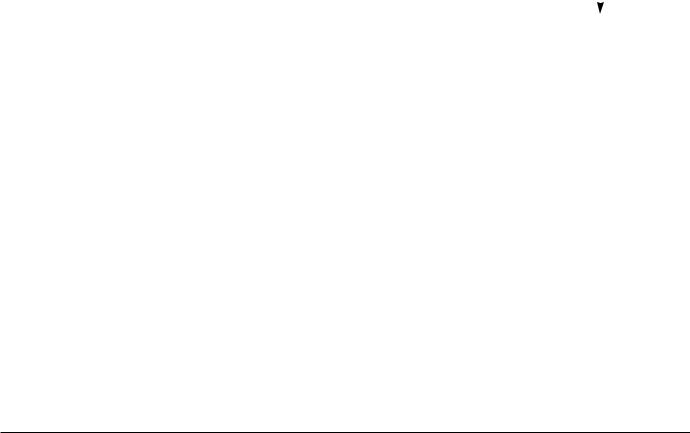
|
|
|
|
|
|
|
|
|
|
|
|
-ALARM HISTORY 1- |
|
|
||||
|
|
|
|
|
|
|
|
|
|
|
|
|
||||||
|
|
|
|
|
|
|
|
|
|
|
|
Package Disch Pressure |
||||||
|
|
|
1 0 0 |
|
|
|
|
|
|
|
|
|||||||
|
|
|
|
P S I |
|
|
|
|
|
199 PSI |
||||||||
|
|
|
|
|
|
|
Package Discharge Temp |
|||||||||||
|
|
|
Ready To Start |
|
|
|
||||||||||||
|
|
|
|
|
|
|
|
|
|
|
|
|
|
103°F |
||||
|
|
|
|
|
|
|
|
|
|
|
|
|
|
|||||
|
|
|
|
|
|
|
|
|
|
|
|
|
|
|
|
|
|
|
|
|
|
STATUS |
|
|
|
|
|
|
MAIN MENU |
|
|
|
ALARM HISTORY |
|
|
|
|
|
|
|
|
|
|
|
|
|
|
|
|
|
|
|
|
|
|
|
|
|
|
|
|
|
|
|
|
|
|
|
|
|
|
|
|
|
|
The name and value of each of the items listed below can be seen by moving the list up and down using the arrow buttons. Pressing the ALARM HIST. button will return the display to the ALARM HISTORY screen.
ALARM HISTORY Items |
|
Discharge Pressure |
Coolant Filter |
Discharge Temperature |
Inlet Vacuum |
Airend Discharge Temperature |
Inlet Filter |
Injected Temperature |
Total Hours |
Sump Pressure |
Loaded Hours |
Separator Press. Drop |
% Load Modulation |
|
Unloaded Inlet Vacuum |
|
Coolant Pressure |
|
Time & Date |
Alarm histories can be exited by pressing either the STATUS or MAIN MENU buttons. If no buttons are pressed within 30 seconds, the display will return to the CURRENT STATUS screen.
3.9 CLOCK FUNCTIONS
|
|
|
|
|
|
|
|
|
|
|
|
-CLOCK FUNCTIONS- |
||||
|
|
|
|
|
|
|
|
|
|
|
|
|
|
|
|
|
|
|
|
1 0 0 |
|
|
|
|
|
|
|
|
|
|
Time |
||
|
|
|
|
P S I |
|
|
|
01:15 |
|
|||||||
|
|
|
|
|
|
|
|
|
|
|
|
|
|
Date |
||
|
|
|
|
|
|
|
|
|||||||||
|
|
|
Ready To Start |
|
|
|
||||||||||
|
|
|
|
|
|
|
|
|
|
|
|
|
|
Jan 01, 00 |
||
|
|
|
|
|
|
|
|
|
|
|
|
|
|
|||
|
|
|
|
|
|
|
|
|
|
|
|
|
|
|
|
|
|
|
|
STATUS |
|
|
|
|
|
|
MAIN MENU |
|
|
|
SELECT |
|
|
|
|
|
|
|
|
|
|
|
|
|
|
|
|
|
|
|
The date and time for the real time clock is set through the CLOCK FUNCTIONS screen. Use the up and down arrows to highlight either TIME or DATE. Select the highlighted setting by pressing SELECT.
If TIME is selected, first the hours will be highlighted. Adjust the hours (00-23 hour clock) by using the up and down arrows. Once the correct time is in the display, press SET to highlight the minutes. Adjust the minutes (00-59) and then press SET to complete setting the time.
If DATE is selected, first the month will be highlighted. Adjust the month by using the up and down arrows and then press SET to highlight the date. Once the correct date is displayed, press SET to highlight the year. Once the correct year is displayed, press SET to complete setting the date.
24

3.10 INTEGRAL SEQUENCING
|
|
|
|
|
|
|
|
|
|
|
|
-INTEGRAL SEQUENCING- |
|
|
||||
|
|
|
|
|
|
|
|
|
|
|
|
|
||||||
|
|
|
|
|
|
|
|
|
|
|
|
|
|
|
|
|
|
|
|
|
|
|
|
|
|
|
|
|
|
|
|
Lead Compressor |
|||||
|
|
|
1 0 0 |
|
|
|
|
|
|
|
|
|||||||
|
|
|
|
|
|
|
|
|
|
|
|
|
Off |
|||||
|
|
|
|
P S I |
|
|
|
|||||||||||
|
|
|
|
|
|
|
|
Total Compressors |
||||||||||
|
|
|
|
|
|
|
|
|
|
|
|
|
||||||
|
|
|
|
|
|
|
|
|
|
|
|
|
||||||
|
|
|
Ready To Start |
|
|
|
||||||||||||
|
|
|
|
|
2 |
|
|
|
||||||||||
|
|
|
|
|
|
|
|
|
|
|
|
|
|
|
||||
|
|
|
|
|
|
|
|
|
|
|
|
|
|
|
|
|
|
|
|
|
|
STATUS |
|
|
|
|
|
|
MAIN MENU |
|
|
|
SELECT |
|
|
|
|
|
|
|
|
|
|
|
|
|
|
|
|
|
|
|
|
|
|
|
Integral Sequencing is set up using the INTEGRAL SEQUENCING screen. A description of integral is in section 7.0. The name and value of each of the integral sequencing setpoints as listed in the right hand column can be seen by moving the list up and down using the arrow buttons.
3.10.1Lead Compressor- The choices for this setpoint are On, Off, Always, and Never. On, means the compressor is the lead unit. Off, means the compressor is not the lead unit, but it could become the lead unit. If Always is selected, the compressor is the lead unit and it will not transfer the lead to another compressor. Never, means the compressor is not the lead unit and will never become the lead unit. The operator must set one unit (and only one) to On or Always to start integral sequencing.
3.10.2Total Compressors- This is the total number of compressors in the integral sequence. This setpoint must be set to the same number on each compressor.
3.10.3Compressor Address- This is the address of the compressor in the integral sequence. No two compressors can have the same address. Two compressors with the same address will cause communication failures.
3.10.4Load Delay Time- This is the number of seconds the lead compressor will wait for the package discharge pressure to start rising after issuing a load command to another compressor. If the package discharge pressure has not started rising at the end of this time period, the lead compressor will load the next compressor in the sequencer.
INTEGRAL SEQUENCING |
RANGE |
STEP |
UNIT |
|
Lead Compressor |
On/Off/Always/Never |
|
--- |
--- |
Total Compressors |
2 to 4 |
|
1 |
--- |
Compressor Address |
1 to Total Compressors |
1 |
--- |
|
Load Delay Time |
10 to 60 |
|
1 |
SEC |
Lead Change - Hours |
0 to 750 |
|
1 |
HRS |
Lead Change - Day |
Sun to Sat, Daily, Week |
1 |
DAY |
|
|
Day, Week End |
|
|
|
Lead Change - Time |
00:00 to 23:59 |
|
1 |
TIME |
|
|
|
|
|
3.10.5Lead Change - Hours- This is the number of hours the compressor will operate as the lead unit. Once a compressor has operated as the lead for this number of hours, it will transfer the lead to the next compressor in the sequence. This setpoint does not apply to a unit where the lead compressor is set to always or never. If this setpoint is set to 0, the next 2 setpoints will determine when the lead is transferred.
3.10.6Lead Change - Day & Lead Change - Time-
These two setpoints are used together. If the Lead Change - Hours setpoint is set to 0, these two setpoints will be used to determine when the compressor will transfer the lead to the next compressor in sequence. Lead Change - Day is the day of the week that the compressor will transfer the lead. Lead Change - Time is the time of the day that the compressor will transfer the lead.
25

3.11 WARNINGS
|
|
|
|
|
|
|
|
|
|
|
|
? |
|
|
|||
|
|
|
1 0 0 |
|
|
|
|
|
|
|
|
|
|
|
|
|
|
|
|
|
|
P S I |
|
|
|
|
|
Change Inlet Filter |
|||||||
|
|
|
|
|
|
|
|
|
|
|
|
|
|
|
|
|
|
|
|
|
|
|
|
|
|
|
|
|
|
|
|
|
|||
|
Running Unloaded |
|
|
|
|
|
|
|
Press RESET Twice |
||||||||
|
Mode: MOD/ACS |
|
|
|
|
|
|
|
|||||||||
|
|
|
|
|
|
|
|
|
|
|
|
|
|
||||
|
|
|
|
|
|
|
|
|
|
|
|
|
|
|
|
|
|
|
|
|
|
|
|
|
|
|
|
|
|
|
|
|
|
|
|
|
|
|
STATUS |
|
|
|
|
|
MAIN MENU |
|
|
|
RESET |
|
|||
|
|
|
|
|
|
|
|
|
|
|
|
|
|
|
|
|
|
|
|
|
|
|
|
|
|
|
|
|
|
|
|
|
|
|
|
|
|
|
|
|
|
|
|
|
|
|
|
|
|
|
|
|
|
When a Warning occurs, a question mark will flash on the display screen and appear in large letters as shown above. The display message will indicate what caused the warning.
If multiple Warnings exist, the small up/down arrows
will appear in the upper right corner of the display screen. The multiple Warnings can be seen by pressing the up and down arrow buttons. Pressing the STATUS button will display the CURRENT STATUS screen with the WARNING button indicating a Warning still exists.
|
|
|
|
|
|
|
|
|
|
|
-CURRENT STATUS- |
|
|
||
|
|
|
|
|
|
|
|
|
|
|
|
||||
|
|
|
|
|
|
|
|
|
|
|
Package Discharge Temp |
||||
|
|
|
1 0 0 |
|
|
|
|
|
|
|
|||||
|
|
|
|
P S I |
|
|
|
|
103°F |
||||||
|
|
|
|
|
|
|
|
|
|
|
|
|
|
|
|
|
|
|
|
|
|
|
|
|
|
|
|
||||
|
Running Unloaded |
|
|
|
|
|
|
|
Airend Discharge Temp |
||||||
|
Mode: MOD/ACS |
|
|
|
|
|
|
|
|
|
193°F |
||||
|
|
|
|
|
|
|
|
|
|
|
|
|
|
|
|
|
|
|
WARNING |
|
|
|
|
|
|
MAIN MENU |
|
|
|
|
|
|
|
|
|
|
|
|
|
|
|
|
|
|
|
|
|
Pressing the WARNING button will return the display to the WARNING screen and the RESET button.
A Warning needs to be reset by the operator by pressing the RESET button twice.
The possible Warning messages are as follows.
AIREND DISCHARGE TEMP- This will occur if the Airend Discharge (2ATT) exceeds 97% of the alarm limit, 228°F (109°C), and is not adjustable.
CHANGE COOLANT FILTER- This warning will occur if the high side pressure is 20 psig (1.4 bar) greater than the low side pressure of 1 DPS, and the Injected Coolant temperature (2CTT) is greater than
120°F (49°C).
CHANGE INLET FILTER- This will occur if the Inlet Vacuum (1AVPT) is greater than 0.7 psig (.05 bar) and the machine is fully loaded (inlet valve is completely open).
CHANGE SEPR ELEMENT- This warning will occur if the pressure on the Separator (3APT) is 12 psig
(.8 bar) greater than the pressure at the Package Discharge (4APT), and the machine is fully loaded.
HIGH DISCHARGE PRESS- This can occur if the machine’s loading function is being controlled by a host device, such as a sequencer or an lSC. This warning will occur when the package discharge pressure is above the maximum offline pressure (rated pressure plus 3 psig [.2 bar]) for more than 3 seconds. This warning will cause the compressor to unload. The host device will not be able to load the compressor until the package discharge pressure falls to the rated pressure of the machine.
SENSOR FAILURE 4ATT- This will occur if the Package Discharge Temperature Sensor (4ATT) is recognized as missing or broken.
AUXILIARY 1 (OR 2) - This warning will occur if either of the auxiliary contacts closes.
HIGH SUMP/LINE DIF - This warning will occur if the compressor is running loaded, the injected coolant temperature is greater than or equal to 120 deg. F, (49°C) the package discharge pressure is greater than 90 psig, (6.3 bar) the sump pressure is greater than the compressor’s rated pressure, and the sump pressure is 25 psig (1.8 bar) or more above the package discharge pressure.
26
